August 1, 2019
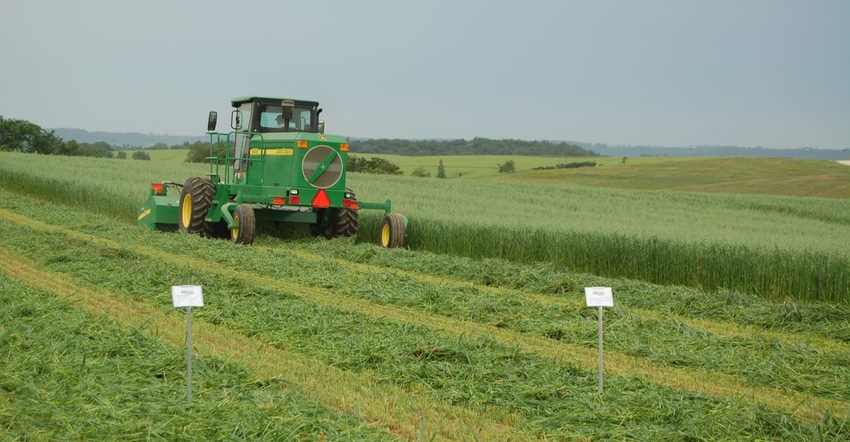
Potato leafhopper activity and plant injury have been reported in some Iowa alfalfa fields during the 2019 growing season. Also, some fields experienced winter injury of alfalfa plants this past winter, and the cooler spring provided a slow start for plant growth in 2019. Now is a good time to assess alfalfa stands.
“Potato leafhoppers do not overwinter in Iowa, but they are persistent alfalfa pests every growing season,” says Erin Hodgson, Iowa State University Extension entomologist.
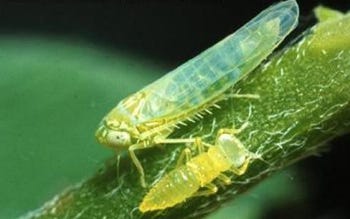 ALFALFA PEST: Potato leafhopper adults as well as nymphs will feed on alfalfa plants. (Photo by Penn State College)
ALFALFA PEST: Potato leafhopper adults as well as nymphs will feed on alfalfa plants. (Photo by Penn State College)

Storms along the Gulf of Mexico bring adult potato leafhoppers north and drop them into fields every spring. Heat or drought stress can make alfalfa plants more susceptible to injury, and plants are more likely to experience injury after the first cutting of hay is harvested. Current climate conditions and harvest activities in Iowa align with these factors, making scouting critical to ensure yield protection.
Hodgson provides the following scouting, management and treatment guidelines for dealing with this insect pest.
Female leafhoppers begin to deposit two to three eggs per day in alfalfa stems as soon as they arrive in the spring. Pale green nymphs emerge in seven to 10 days depending on temperature; the fastest development occurs at 86 degrees F. They go through five instars (growth stages) in about two weeks. Thus, a large population could develop three weeks after the northern migration. The extended egg-laying period can result in at least two overlapping generations in Iowa every year.
Causing injury to alfalfa plants
Potato leafhopper nymphs and adults have piercing-sucking stylets. They cause physical injury to plants when probing to feed, and they also inject saliva that plugs the plant’s vascular tissue. Initially, alfalfa leaf tips will turn yellow, which is commonly referred to as “hopperburn.”
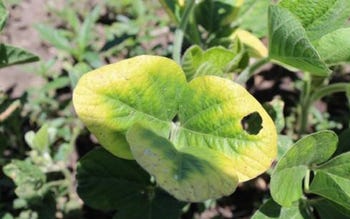 ALFALFA INJURY: Typical hopperburn is caused by potato leafhopper feeding. Note the V-shaped yellowing pattern. (Photo by Rebecca Vittetoe)
ALFALFA INJURY: Typical hopperburn is caused by potato leafhopper feeding. Note the V-shaped yellowing pattern. (Photo by Rebecca Vittetoe)

Heavily infested plants will be stunted, and new stands of alfalfa and regrowth after cutting are particularly affected. In some cases, large leafhopper populations can significantly reduce tonnage of the current hay crop, as well as the following crop.
How to scout for pest
Potato leafhoppers do not typically build up to damaging levels during the season’s first crop (for the first cutting of alfalfa during the growing season) in Iowa. Fields should be monitored weekly after the first cutting until the end of the season, Hodgson says.
A sweep net is the most effective way to sample for potato leafhoppers because adults and nymphs are very active and easily disturbed. Adults will jump or fly away, while nymphs quickly move sideways and backwards. A detailed description on how to make and use a sweep net is available here.
Fields should be sampled during calm conditions and when dry. Sweep vigorously through foliage, using a 180-degree motion for one sweep. For each field, stop at four to five locations and take 25 sweeps per location. Count the number of nymphs and adults at each location and estimate the number of potato leafhoppers per sweep for each field. Typically, nymphs will be near the sweep net ring; adults will be at the bottom of the net.
3 keys to managing leafhopper
“Remember, healthy and vigorous alfalfa stands are able to tolerate some potato leafhopper feeding and also other insect feeding,” Hodgson says. Protecting alfalfa from potato leafhopper, she notes, usually involves a three-pronged approach:
1. Planting glandular-haired alfalfa varieties. This type of alfalfa variety has hairs on the leaves and stems. More than 70% of alfalfa today is resistant to potato leafhopper. Adults are repelled by plant hairs, and nymphs get caught in the sticky hairs and starve.
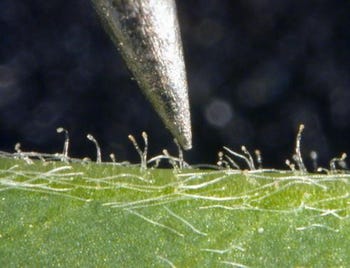
PROTECTION: Glandular-haired leaf and stem characteristics protect against leafhopper. (Photo by Purdue Extension)
Newly planted resistant fields may not show resistance immediately but should develop sticky hairs after becoming established. Glandular-haired alfalfa is not the same as non-yellowing varieties. These tolerant plants, the non-yellowing varieties, only hide leafhopper feeding and do not prevent yield loss.
2. Cut alfalfa stands to disrupt leafhopper development. Delaying harvest will allow nymphs enough time to become adults and start reproducing. Timely cutting will destroy or starve young nymphs before regrowth occurs and force adults to move to nearby crops, but they often move back into a field as the alfalfa regrows. It’s important to start scouting seven to 10 days after each cutting to monitor for possible re-infestations.
3. Apply insecticide. This can protect alfalfa yield from potato leafhoppers and are economically justified with regular scouting and the use of economic thresholds. The fluctuating values of hay and control costs are important considerations for making a treatment decision. The table below offers a dynamic threshold to use for deciding when to treat for potato leafhopper.
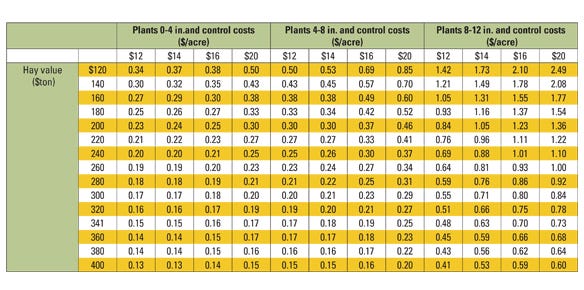
Economic threshold for potato leafhopper, based on the average number of leafhoppers per sweep (originally published by John Tooker, Penn State Extension)

Several insecticide products are registered in Iowa for potato leafhopper control in alfalfa. Follow label directions and pay attention to preharvest interval guidelines.
Source: ISU, which is responsible for information provided and is wholly owned by source. Informa Business Media and its subsidiaries aren’t responsible for any of the content in this information asset.
You May Also Like




